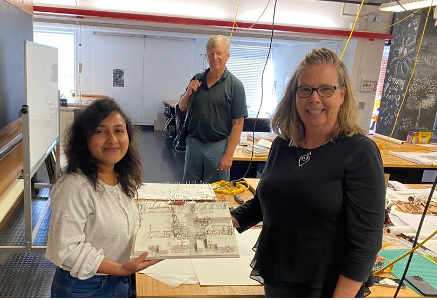Lessons for UDL from the genesis of Universal Design: Echoes from the past, portents for the future

By: Dr.Seán Bracken, Head of Department for Education and Inclusion, School of Education at the University of Worcester.
A recent chance encounter at Logan Airport in Boston, while in transit from Ireland to Charlotte Airport in North Carolina, led to a historical odyssey into the fledgling beginnings of Universal Design at North Caroline State University (NCSU). At NCSU, the inspirational architect Ron Mace initially developed the concept of anticipatory design planning for accessibility. While chatting with Emeritus Professor Art Rice in Boston, he mentioned that he had been a colleague of Mace’s when he led the respected Centre for Universal Design, founded at NCSU in 1989. As luck would have it, my family and I were guests at a family wedding in Raleigh, so I was able to avail of Art’s invitation to visit NCSU’s College of Design where Mace had been a professor.
Rice explained that historically the College of Design was founded by Henry Kamphoefner and influenced by the philosophies of the Bauhaus. In Mace’s time then, the post-war influences had a distinctively Bauhausian flavour. The Bauhaus movement was concerned with the interrelationships between people and their environments. It was a social movement that considered materiality and artistic expression as a core aspect of the human experience. Clearly, Mace’s thinking would have been informed by these European ideas prompting designers to consider ways that the build environment would influence people’s social well-being as they interacted with physical spaces. For Mace, as a wheelchair user, the notion that architectural designers have a social and aesthetic responsibility would have been accentuated, and the disabling attributes of supposedly shared spaces would have prompted him to seek out new principles of inclusion to inform novel design processes with the goal of making the built environment accessible to all. Ultimately, this quest led Mace to create the approach known as Universal Design.
Somewhat disappointingly, the College’s Centre for Universal Design is no longer. Rice explained that Mace was a very influential and passionate advocate for inclusive design, however the Centre he had established may have been too closely aligned with his personal commitment rather than being a shared endeavour with a wider cohort of colleagues. However, with such a strong heritage of inclusivity permeating the College of Design, Rice stated that Mace’s legacy, and that of Universal Design, are very much embedded within the College’s current culture. This cultural orientation towards inclusive design is evident, for instance, in the work of the Natural Learning Initiative (NLI – https://naturalearning.org), which, according to its website, aims to create ‘environments for healthy human development and a healthy biosphere for generations to come.’ The initiative is premised on a purposeful collaboration with communities while designing sustainable living, working, and learning spaces in schools, museums, and other public places. Such design-based thinking takes cognisance of community-oriented strategies that are purposefully initiated to prompt physical activity, foster food awareness, and promote healthy eating. These dynamic interfaces between space, health and education are referred to as ‘biotopic planned learning areas.’ Their ongoing design and use then become a focus for participant engaged action-research, so that stakeholders continuously learn more about the influences that these spaces have on young people’s living and learning.

The strong social foundation underpinning NLI’s approach to design resonates with the Universal Design for Learning’s (UDL) fundamental requirement that educators need to actively foster the affective dimension to students’ learning. On my walk through the College, it was clear that design-based thinking encouraged students to experiment with both digital and tactile models in research-informed, problem-solving ways. Students were prompted to engage with authentic learning while they iteratively developed ever better models of the built environments they wished to create. This too resonated with the UDL framework, where it is suggested that learners be provided with multiple means of engagement. Students’ creations were visible in differing formats, reflecting another core facet of UDL where students evidence their learning through various forms of action and expression.
At a crucial time in the continued evolution of the UDL framework, it is timely to (re)consider the positive influence that Universal Design principles have had on the formative development of UDL and their potential to inform future iterations of the framework. Following my visit into the historical heartlands of Universal Design, I can see how UDL may be imagineered to boldly incorporate the common good through a conscious highlighting equity of access and accessibility. Guided by Universal Design principles, UDL could more boldly consider how socio-culturally sensitive curricula are designed to promote the well-being of all, using iterative processes that are collaboratively and democratically co-constructed. As the future for UDL is at somewhat of a crossroads, recalling the historical wellspring of insight provided by Ron Mace and other architects at the Centre for Universal Design, and investigating their impact on current inclusive environmental planning, certainly stimulates thinking about a need to extend UDL beyond an ‘in-person’ model for curriculum, resource, and spatial inclusion. The early work of design-based practitioners and researchers continues to challenge the status quo, their achievements provide inspiration for educators who are committed to a more equitable and socially just learner experience across the life course.